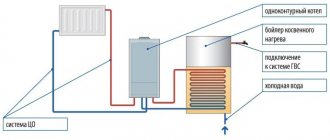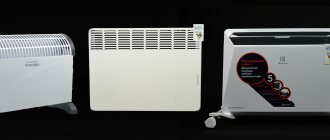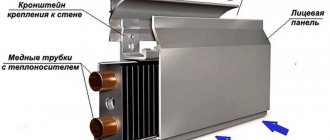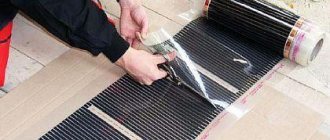What is infrared radiation
Infrared radiation is a type of thermal energy. It is otherwise called “thermal radiation”. It is produced by incandescent lamps and also accounts for about half of all solar radiation. This is electromagnetic radiation whose wavelength ranges from 0.74 microns to 2000 microns (which is 2 mm). It cannot be seen with the naked eye; there are special devices to register it.
This energy comes in several types:
- near λ = 0.74-2.5 µm;
- average λ = 2.5-50 µm;
- far λ = 50-2000 µm.
Part of the mid-wave infrared radiation, namely from 7 to 14 microns, has properties that can have a positive effect on the body, since this wavelength corresponds to the natural radiation of the human body.
The benefits and harms of infrared radiation for humans
Today we are surrounded by a wide variety of household appliances that produce infrared radiation. Few people think about the impact it has on a person. But if your health is important to you, then you should pay attention to this issue.
According to scientific terminology, infrared radiation is usually called electromagnetic radiation whose wavelength is longer than the red end of visible light, but shorter than microwave radio emission. In numerical terms, its length can be from 0.74 microns to 1-2 mm.
The discovery of infrared radiation is credited to the astronomer William Herschel, who made it in 1800. It is known to many as “thermal radiation”. Infrared waves differ little from ordinary light, so they have similar properties. When light reaches an object, it is reflected to the original point.
In the case of infrared waves, their complete absorption by the body is observed, resulting in the formation of thermal energy.
There are three types of infrared waves:
- short (0.74 – 2.5 µm);
- medium (2.5 – 50 µm);
- long (50 – 2000 microns).
Infrared waves are emitted by all objects that surround us, and this happens when they are heated to a certain temperature. Among the most famous sources is the Sun.
Using Infrared Energy
Infrared radiation did not go unnoticed by scientists, who, after its discovery, were able to find worthy uses for it. There are several main areas where infrared waves are actively used:
- Thermography . Infrared waves make it possible to remotely determine the temperature of objects located at a distance from the researcher. In recent years, thermal imaging has been widely used in industry as well as in the military field. The military has special cameras designed to detect infrared waves, which, after finding the source, create an image of this radiation. Their work is based on the fact that every heated body emits infrared waves. Using thermographic cameras, you can determine the presence of any objects that are located nearby without lighting.
- Tracking . Waves of this type are successfully used by many countries to guide missiles. This function is performed by electronic systems independently without human intervention. For this purpose, rockets are equipped with a special device - heat seekers. Whatever body stands in the path of the rocket, be it an airplane or a car, it can always be seen in the infrared spectrum, and the rocket’s trajectory can be adjusted.
- Heating. Infrared radiation has also been actively used as a heat source to create favorable indoor conditions. In addition, there is evidence of the positive effect of waves of this type on health. This led to the creation of infrared saunas, which have a beneficial effect on the human body. Infrared heaters are widely used in medicine, as well as in the industrial sector - they are used for curing coatings, annealing, and welding plastics.
- Meteorology . To make accurate forecasts, it is often necessary to determine the height of clouds, their type, and the temperature of the water and ground surfaces. For this purpose, special satellites have been created that take infrared images. The images obtained with their help show the location of ice clouds, which are white in color, and warm ones, which are gray in color. The hottest areas of the earth are marked in black or gray. You can receive this information even in the dark. This information is of great value to fishermen and farmers.
- Astronomy . Based on infrared radiation, special telescopes have been created that make it possible to observe celestial objects. Such instruments allow scientists to detect protostars before they begin to emit visible light. Detecting new planets in the visible spectrum is extremely difficult due to the fact that stars drown out the light reflected from the planet. This problem is successfully solved by infrared telescopes, which easily detect cool objects. These instruments are indispensable when observing the nuclei of galaxies that are inaccessible for control due to dust and gas clouds that hide them from view.
- Art . An interesting device that was created thanks to infrared waves is reflectograms. They help art historians discover the underlying layers, the artist's sketches. This method is actively used in cases where it is necessary to compare drawings and the visible part of the painting to confirm the original of the painting, as well as determine whether it has been damaged by restoration work. This device brings invaluable benefits when studying ancient written documents, allowing carbon black to appear. This substance was used many centuries ago to create ink.
But this is only part of the areas in which infrared radiation is actively used today. But this process does not stop, and every year new devices using infrared waves appear.
Benefits of infrared radiation
People have long suspected the existence of infrared radiation, so even in ancient times it was known about the healing properties of this technique. heated clay, sand in the fight against ailments , which never failed. Subsequently, experts managed to find out that infrared radiation can be used in medicine.
Medicinal properties
There was a time when people thought that infrared waves had no effect on the human body. Cases where, as a result of the use of this radiation, a person unexpectedly recovered were explained by the effects of heat.
But recently, many new studies have been conducted that completely refute this hypothesis.
The benefits for the human body from infrared waves are very significant; if used correctly, many diseases can be successfully treated:
- Infrared radiation can be used to treat fractures;
- Proven positive effects in the treatment of paralyzed patients;
- Allows you to normalize metabolism in the body, and also provides invaluable assistance in the fight against fat deposits;
- Has wound healing properties;
- Helps normalize blood circulation;
- Has a positive effect on joints and muscles.
Application in medicine
Infrared radiation has been used for quite some time in operations .
There is evidence that as a result of exposure to infrared waves in the postoperative period, patients do not feel pain, or at least they manifest themselves in a weak form, and the process of cell rehabilitation is noticeably faster.
But this is only a small part of the positive effects of infrared waves on the human body. In fact, they can bring even greater positive effects if this technique is used correctly.
According to experts, therapy based on infrared radiation helps speed up the body's recovery process after illness. The effect is especially striking when using IR radiation to treat a group of diseases:
- Chronic inflammatory processes;
- Poorly healing bedsores, wounds and ulcers;
- Burns and frostbite;
- Joint damage;
- Neuralgia, radiculitis, etc.
Scientist Rustam Rakhimov
Many experts have repeatedly cited evidence of the positive effects of infrared waves on the human body. However, the greatest success in studying this effect was achieved by the Uzbek scientist Rustam Rakhimov from Tashkent.
He is a recognized geophysicist and chemical physicist. He spent about 30 years on his own studies of this phenomenon, actively using the knowledge of other scientists.
As a result, he was able to create a way to use infrared radiation.
The proposed solution helped cure many diseases. The theory proposed by Rakhimov was given scientific status, and today it is included in the curriculum of every Russian university. Moreover, this method is well known outside our country - it is actively used in clinics in the USA, Europe, Thailand and other countries.
Harm from IR radiation
Once again, I would like to remind you that infrared waves can be emitted in the long, medium and short spectrum. Waves of the long and short spectrum benefit the body, which cannot be said about short ones.
Not only do they not provide any benefit, moreover, with prolonged exposure, a person can feel harm from them. A person is also a source of infrared waves, which have a length from 2.5 to 20-25 microns.
If a person is exposed to radiation of the same length as the waves emitted by him, then this does not harm him.
Harm from IR radiation
The effect is completely different if human brain tissue is exposed to short infrared waves. In this case, a phenomenon called sunstroke occurs.
This manifests itself in a deterioration in health: a person has complaints of pain, dizziness, increased heart rate and breathing, darkening of the eyes, and in especially severe cases, fainting may occur. If a person continues to be exposed to radiation, then the body simply will not have enough strength to cope with it.
As a result, swelling of the tissues and membranes of the brain will occur, and signs of encephalitis and meningitis will begin to appear. All this seriously worsens a person’s quality of life.
Short infrared waves have a particularly negative effect on the eyes. If this exposure continues for too long, there is a risk of developing infrared cataracts.
There is a lot of evidence that infrared waves can also harm the cardiovascular system. This is especially true for personnel in hot shops , whose work takes place in rooms with high levels of infrared radiation.
Ultimately, this leads to the development of heart and digestive diseases.
According to statistics, in approximately 23.6% of cases, people employed in the metallurgical industry become disabled due to heart disease. One year of work in hot shops is enough to significantly weaken the immune system. And therefore, after this period, many workers begin to show symptoms of colds.
How to protect yourself from infrared radiation?
To minimize possible harm as a result of exposure to infrared radiation, special standards have been developed that are safe for humans.
Today in our country there are special hygiene standards established by SANPIN , designed to ensure a favorable microclimate in the workplace.
All organizations are required to take measures to improve human protection at work.
- Reducing temperature and radiation intensity.
- Particular attention is paid to monitoring the employee’s thermal condition so that it does not exceed acceptable standards. Attention should also be paid to protecting human eyes and skin from infrared waves.
- For safety reasons, new equipment is used, and, if possible, automated production is introduced.
- To protect against the risks posed by infrared radiation, businesses are being asked to eliminate hot metal jobs. Now processes are controlled in a safe environment - in the office.
- A location in the room is selected for the equipment to minimize the harmful effects of thermal radiation.
- Workers are allowed to remain in the heating environment for a minimum amount of time. To protect them, special screens are offered.
- In the absence of the above protective devices, cooling screens or means capable of increasing the air ventilation rate must be used.
- Workers must perform their duties in special clothing that can protect the most vulnerable areas of the body from radiation.
- Workers in particularly hazardous professions are recommended to undergo treatment and preventive measures - regular medical examinations, work and rest in conditions favorable to health.
Conclusion
Infrared radiation was discovered 200 years ago , and during this time scientists were able to establish that it brings not only benefits, but also harm. Although infrared heaters and other devices that use this type of wave are used everywhere today, it is not safe for humans.
Therefore, those people who have to expose themselves to prolonged exposure to infrared radiation need to take measures to protect themselves from it.
If it is not possible to work in safe conditions, then it is necessary to use special protective equipment and, in addition to this, minimize the time spent in areas hazardous to health.
Source: https://bane.guru/kak-poseschat-banyu/polza-i-vred-infrakrasnogo-izlucheniya-dlya-cheloveka.html
Infrared radiation sources
Infrared rays belong to electromagnetic radiation. They are located in the spectrum next to microwave radio emission. The sun is the natural and largest source of such radiation. These waves have a wide range from 7 to 14 microns.
Any body whose temperature is above zero is also a source of thermal radiation. The length of such waves directly depends on the heating temperature. The following types of waves are distinguished:
- short - above +800°C;
- medium - up to +600°C;
- long - up to +300°C.
Thus, short waves have the highest temperature and highest radiation intensity. Heat rays are formed due to ions of the substance, as well as atoms with excess energy. Each range of infrared waves has its own intensity, penetrating ability and has a different effect on the human body.
In this video you will learn about the effects of various radiations on the body:
Nowadays, infrared rays are actively used in many areas. For example, modern video cameras that are used for security purposes, bolometers and many other devices operate on their basis. With the help of such beams, wireless communication is carried out between computers and other stationary devices.
On sale you can find a wide variety of heating devices that operate using infrared rays. Such devices can significantly save energy. For industrial purposes, they are used for drying surfaces coated with paint or varnish.
Benefits and harms
Infrared rays affect living organisms in different ways. For example, long waves have a healing effect on human health, so they are often used for medicinal purposes. It is on this principle that the operation of equipment for physiotherapeutic procedures is based.
Infrared devices can be both beneficial and harmful
Long-wave infrared rays have the following positive effects on humans:
- improve cerebral circulation and memory;
- strengthen the immune system;
- normalize water-salt balance;
- improve hormonal levels;
- normalize blood pressure;
- cleanse the body of toxins and heavy metal salts;
- prevent the proliferation of bacteria, fungi and pathogens.
Rays also help with inflammatory processes in the body, increase insulin levels in patients with diabetes and even reduce the level of radioactive radiation.
Thus, long-wave infrared radiation is not only useful for humans, but also necessary for them. With a lack of such rays, the immune system suffers and the process of accelerated aging begins.
In this video you will learn what infrared heat is:
Heaters based on infrared rays eliminate various harmful and dangerous bacteria, and special IR lamps help with:
- radiculitis;
- disruption of ovarian function;
- bronchial asthma;
- osteochondrosis;
- disruption of the mucous membrane.
Also, using such an irradiator, you can cure pneumonia, prostatitis in the acute stage, rhinitis, tonsillitis and otitis media without purulent formations.
Despite the large number of useful and medicinal properties, this device has contraindications. Infrared radiation is harmful to humans if they have acute inflammatory diseases.
Such rays should not be used for malignant tumors, acute purulent diseases and bleeding. Infrared rays may cause side effects
Short waves also cause great harm to infrared radiation on the human body. The following symptoms may appear under their influence:
- nausea;
- severe dizziness;
- darkening of the eyes;
- fainting;
- impaired coordination of movements;
- cardiopalmus.
Usually, under the influence of such rays, the skin begins to turn red, burns and convulsions may appear. Prolonged exposure to short waves leads to disruption of the water-salt balance or heat stroke. Such radiation also poses a great danger to the mucous membrane of the eyes, as it can lead to the development of photophobia, cataracts and other vision problems.
More details about the infrared heater:
First aid for heatstroke
With intense or prolonged exposure to short waves, heat stroke can occur. This usually happens if the temperature of the brain rises sharply by at least 1 degree.
In this case, the victim should immediately receive first aid. To do this, you need to carefully shift it or transport it to a cool place and try to remove tight clothes from it.
Apply something cold to your heart, head, armpits and groin area.
After this, the victim needs to be wrapped in a wet sheet and air from a fan directed at him.
These actions will help lower your body temperature. In severe cases, artificial respiration should be performed and an ambulance should be called. During this time, the victim should be given cool and plenty of fluids.
Heating devices
Infrared heating devices have become very popular over the past few years. And many people, when purchasing them, do not even know that they can have a negative impact on humans.
The advantage of infrared heaters is the instant heating of the room
Infrared radiation can be harmful if exposed to it continuously and for long periods of time. Therefore, when purchasing a heating device, you need to pay attention to the nature of its radiation.
Such data is usually indicated in the technical data sheet. Preference should be given to heaters in which the heating element has heat-insulating protection. In this case, the device will emit long waves, which, on the contrary, are good for health.
If the coil that generates heat is not insulated, then such a device transmits short waves and can harm a person. It is undesirable to stay near such devices for a long time. They should not be installed in bedrooms and children's rooms. If this still needs to be done, then preference should be given to low-power models.
More details about the infrared heater:
When installing a heating system on the ceiling, it should be done at the greatest possible distance. At the same time, it is better to direct it in such a direction that you are not constantly exposed to infrared rays. You need to buy IR heaters only from trusted manufacturers. Made from low quality materials, they can cause irreparable harm to health.
Infrared radiation can be both beneficial and harmful to human health. You need to treat it with extreme caution, and devices based on it should be used in accordance with all safety rules.
Source: https://kamin.spb.ru/izolyaziya/obogrevatel-polza-infrakrasnogo-izluchenija/
The influence of infrared radiation on the human body
Intentional use of the properties of infrared rays benefits the human body. Here are examples of exactly how they contribute to overall health:
- The rays help destroy pathogenic bacteria, thereby helping in the fight against colds.
- The action of infrared rays strengthens the immunity of children and adults.
- Doctors also noted their benefits for the skin. By increasing blood flow, it is easier for the skin to receive the necessary substances, as a result of which it becomes more toned.
- The cosmetic benefits of rays for the skin are unlimited. Numerous studies show that they help cure skin diseases such as urticaria, psoriasis, and dermatitis.
- The saturation of a confined space with infrared radiation helps reduce the harm from dust to the human body.
Infrared treatment
Thus, the benefits of infrared radiation for humans are achieved through the following mechanism:
- The heat coming from the rays triggers and accelerates biochemical reactions.
- First of all, tissue regeneration processes begin to intensify, the network of blood vessels becomes wider, and blood flow accelerates.
- As a result, the growth of healthy cells becomes more and more intense, plus the body begins to independently produce biologically active substances.
- All this reduces blood pressure due to better blood supply, thereby achieving muscle relaxation.
- Provides easy access of white blood cells to foci of inflammation. This leads to strengthening the immune system and strengthening the body’s protective functions in the fight against various diseases.
It is thanks to these special properties that a general strengthening effect for the body is achieved when treated with infrared rays.
During treatment, both the entire body and some of its affected parts can be exposed to irradiation. Procedures can be performed up to 2 times a day, and the session lasts up to half an hour. The number of procedures depends on the patient's needs. To avoid harm, during sessions it is imperative to protect the eyes and the area around them from exposure to radiation. Various methods are used for this.
The benefits of infrared rays
The benefits of using infrared rays in medicine have been scientifically proven. General improvement of human health, treatment of bacterial infections, lowering blood pressure and muscle relaxation - this is an incomplete list of the positive aspects of this amazing discovery.
Man, thanks to his perseverance, managed to find useful application for this amazing phenomenon in the most diverse and sometimes even unrelated areas of his activity. Of course, behind all this there is a careful study of the properties of rays.
Areas of application of infrared radiation
It is used in the food industry, in physical and chemical analysis, as well as in many other areas:
- It is used to sterilize food.
- In food production, rays are used not only for heat treatment of raw materials, but also to accelerate biochemical reactions in it.
- IR spectroscopy is a method of qualitative and quantitative analysis that allows one to determine the structure of many molecules due to the special properties of infrared radiation.
- This technology is also used when checking banknotes for authenticity. When making banknotes, they are marked with special dyes that can only be seen using infrared rays. It is very difficult for fraudsters to counterfeit such money.
- The properties of infrared rays are useful for use in night vision devices that read objects in the dark.
- The beams are used for remote control.
Shortwave infrared spectrum: benefits for imaging
Short-wave infrared radiation includes wavelengths from the range of 0.9 - 1.7 microns, but sometimes short-wave infrared is also defined in the range of 0.7 - 2.5 microns. Since ceramic photosensors detect radiation down to 0.1 µm in length, imaging the short-wavelength IR spectrum requires special optics and electronics.
Basically, receivers equipped with an InGaAs matrix are used as photodetectors when working with the short-wave IR range. The working area of such photodetectors covers almost the entire region of the short-wave IR spectrum, from the lower limit (550 nm) to the upper limit (2.5 µm). Despite the economic availability of linear scanning photodetectors, area scanning photodetectors are more popular - they are actively used even in the military industry due to their structural rigidity, reliability and stability of the configuration for long-term transportation. It should be noted that some photodetector devices require a license to use.
Figure 1. Electromagnetic spectrum of the short-wave infrared region
Benefits of Shortwave Infrared Imaging
Unlike mid- and long-wave IR radiation, short IR waves do not come from the object itself, but are refracted and absorbed by it, like visible radiation. Thus, the picture acquires high contrast. Contrast makes it easier to solve the problem of increasing resolution. Natural sources of short infrared waves are stars and the moon, visible in the night sky due to illumination by background radiation.
To obtain high-quality visualization, specialized optics are also required: lenses, objectives, the coatings of which must also be designed to work in the short-wave IR range. The use of lenses not designed for short-wave infrared will cause a decrease in imaging resolution, also increasing optical aberrations.
Since the radiation of this region passes through glass, lenses, filters and windows, like the visible one, there are no fundamental differences in the production of optical components for the visible and IR regions. Security windows and filters can also be directly integrated into systems.
Many tasks where it is theoretically recommended to use visible radiation are in practice solved using short IR waves: water vapor, fog and similar media do not affect such radiation, while visible light sources are sensitive to environmental conditions.
Visualization in visible light and in the short-wave infrared range
IR spectrum imaging is used in a variety of applications, including electronic circuit board inspection, solar cell inspection, product inspection, identification and sorting, surveillance, anti-counterfeiting, quality control of manufacturing processes, etc. To understand the benefits of this type of imaging, let's look at some clear examples of common everyday products imaged using visible light and short IR waves.
Figure 2. a) Visualization of a red apple in the visible spectrum: the apple appears uniform, absolutely red, without any defects, b) IR visualization of the same fruit, but now a defect on the peel is clearly visible, the quality of the product is in doubt
Figure 3. a) Visualization of a matte one-color bottle with baby powder in the visible spectrum, the contents of the bottle are not visually traced, b) visualization of a matte one-color bottle with baby powder in the short-wave IR spectrum: the contents of the bottle this time are clearly recognized, the amount of product can be assessed
Figure 5. a) Painting “Bountiful Fruit” by Philadelphia artist Nicole Koenitzer in the visible range, b) Visualization of the painting in the IR spectrum: the initial sketch of the painting contains images of bananas in the background, a frame that is not in the final result, in the lower right corner strokes are noticeable, probably the artist began to paint the picture from the background and, most likely, the oil was not chosen right away
The short-wave infrared region is considered to be a very specific range, which requires specialized optics with coatings designed for this range. It remains to once again emphasize the importance of careful selection of components for imaging in the short-wave IR range. If all requirements are met and equipment parameters are consistent, aberrations and a decrease in image resolution can be avoided.
Edmund Optics has developed high-performance filtering and anti-reflective coatings for lenses and transmission components specifically for IR imaging.
© Edmund Optics Inc.
INSCIENCE company helps its customers solve any questions and needs regarding Edmund Optics in the Russian Federation
Harm and consequences of exposure to infrared rays
Strong exposure to infrared light does harm, not good, to the membrane of the eye, or, more precisely, dries it out. It occurs in very hot areas.
Strong radiation also causes skin burns. In this case, redness of the skin occurs first. Occupational diseases of people who are often exposed to radiation in the workplace include diseases whose symptoms include skin lesions. Neoplasms may also occur. Milder consequences of harmful effects include dermatitis, which is also a difficult disease.
Disadvantages of exposure to IR emitter
All infrared heat rays, affecting the body of a living being, and in our case a person, contribute to a rush of blood and acceleration of blood circulation in this place. Visually this is expressed in redness of the skin. Therefore, the most obvious negative manifestations from the abuse of heat rays, including solar radiation, can be various types of bleeding, provocation of suppuration and inflammatory processes, blood diseases, the formation of malignant tumors and neoplasms.
As mentioned above, the length of infrared waves is in the range from 0.75-100 microns. However, not all waves have the same effect on a living organism. The most adverse effects on the body are caused by short- and medium-wave radiation, which include heat rays with a wavelength from 0.75 to 5.6 microns, namely medium waves - from 2.5 to 5.6 microns; short waves - from 0.75 to 2.5 microns.
- Thus, excessive irradiation, especially with short and medium waves, can cause burns or tumors on the skin, lead to dermatitis, and heat stroke.
- Infrared short-wave heat rays have a destructive effect on the retina of the eye, which can lead to cataracts, photophobia and other vision disorders.
- For this reason, short-wave emitters are not used to heat residential premises and places where people and animals are located. Their destiny is to heat industrial premises.
Contraindications to the use of infrared radiation
The use of infrared radiation as a therapeutic or prophylactic procedure should be avoided in the following cases:
- pregnancy and lactation;
- frequent bleeding;
- purulent processes;
- chronic diseases in the acute stage;
- blood diseases;
- oncological diseases.
The special properties of infrared radiation in these cases can cause harm to the body, which will aggravate existing diseases. In the presence of such contraindications, such treatment will definitely not bring benefit.
Should I use infrared light for my process?
Yes.
Ceramicx are experts in the infrared industry. We can advise you on the best practices for using infrared for your material from design to production of what you need. Proper delivery and execution of infrared heating can lead to significant increases in productivity and efficiency. Approximately 30% minimum.
When choosing an infrared emitter for a specific heating task, the absorption characteristics of the target material are of great importance. Ideally, the emitted infrared frequencies and the absorption frequencies of the target material should match to ensure the most efficient heat transfer.
There is a difference in the type of infrared heating that can be used depending on the material. Some materials will absorb better using ceramic, some will require a high intensity halogen infrared heater, and some will require a medium intensity quartz type heater. Ceramicx makes them all.
Below is an illustration of the radiant output of our types of ceramic elements.

At longer wavelengths, the amount of energy transferred will be less due to the lower emitter temperatures, so the heating time will usually be longer. The shorter the wavelength, the higher the temperature of the emitter, and the available infrared power increases rapidly.
How to Avoid Harmful Exposure to Infrared Radiation
The pathogenic effect on the body of infrared rays occurs if they are short-wave. Their main sources are household heaters. Thus, in order to avoid harm to the body, you should either limit their use in everyday life as much as possible, or stay as far as possible from the heat source. In this case, household infrared radiation is very harmful. The instructions supplied with the safety heater must indicate that its surface is covered with a material protected from heat, or that its radiation surface is less than 100 o C. They emit only long waves, the properties of which will not cause harm to health, even may provide some benefit.
Sources of harmful exposure can be encountered at work. These can be various technical furnaces. To protect against the harmful properties of rays, workers are required to be provided with special clothing and equipment that will minimize harm.
Are there any health benefits?
Of all types of infrared heaters, the safest, and in some cases those with useful properties, are long-wave IR heaters. Today, there are no known negative effects on the human body from long-wave infrared heaters. They are increasingly finding their use in medicine, from which we can conclude that long-wave infrared heaters have a beneficial effect on the body. Clinics in many countries around the world, including Russian ones, use long-wave infrared radiation to warm the body. This is due to the fact that long waves penetrate as deeply as possible into the tissues and the body as a whole, thereby ensuring its heating. In this case, the property of “resonant absorption” is used (this is when the length of the emitted wave coincides with the wavelength emitted by the person himself). The spectrum range of infrared radiation of the human body is 70–200 microns. Thus, when the human body is exposed to long-wavelength infrared radiation, thermal energy is actively absorbed by the body and heat treatment occurs, which is so often used in physiotherapy rooms. Long-term research by scientists has shown that long-wave or far-infrared radiation not only has a positive effect on the human body, but also contributes to the healing and treatment of many skin diseases (neurodermatitis, allergic irritations, psoriasis). Long-wave infrared radiation also has a beneficial effect on the healing of wounds and cuts, suppresses the growth of cancer cells, improves the health of patients with diabetes and generally has a positive effect on the body of a healthy person.
Where is the use of rays applied (photo)
Some devices are very small and easy to handle Effects on skin diseases Use in beauty salons and beauty clinics General warming of the body
First aid for heatstroke
If complications cannot be avoided, it is necessary to take a set of certain measures.
When providing first aid for heatstroke, the following steps should be taken.
- Call an ambulance.
- Move the victim to a cool place, preferably in the shade, where there is access to fresh air.
- Make it easier for him to breathe by removing or unbuttoning his clothes. Give validol.
- Place the victim in a horizontal position, raising his legs.
- Give the victim 1 liter of water with a little salt.
- Cool the person by wrapping him in a cold wet towel and applying ice to his forehead.
- In case of loss of consciousness, it is necessary to give the victim a sniff of ammonia.
The benefits of infrared rays for humans
Long-wave infrared rays are beneficial to human health. It is often used in medicine, particularly in physiotherapeutic procedures, which can improve blood circulation, metabolism and neuroregulation.
The positive effect of infrared radiation on the human body is as follows:
- memory and brain function improves,
- blood pressure is normalized,
- hormonal balance is normalized,
- salts, toxins and heavy metals are eliminated,
- the proliferation of fungi and harmful microorganisms stops,
- water-salt balance is restored,
- pain relief occurs
- an anti-inflammatory process occurs
- cancer cells are suppressed
- the results of radioactive radiation are neutralized,
- insulin increases in diabetic patients,
- dystrophy is cured,
- psoriasis goes away,
- immunity is strengthened.
Heating using infrared rays kills harmful bacteria and helps strengthen the immune system. Air ionization protects against allergic manifestations. Long waves of infrared heat have a calming effect on fatigue, irritability, stress, promote wound healing, and lead to recovery from the flu.
Are there any health benefits?
Of all types of infrared heaters, the safest, and in some cases those with useful properties, are long-wave IR heaters. Today, there are no known negative effects on the human body from long-wave infrared heaters. They are increasingly finding their use in medicine, from which we can conclude that long-wave infrared heaters have a beneficial effect on the body. Clinics in many countries around the world, including Russian ones, use long-wave infrared radiation to warm the body. This is due to the fact that long waves penetrate as deeply as possible into the tissues and the body as a whole, thereby ensuring its heating. In this case, the property of “resonant absorption” is used (this is when the length of the emitted wave coincides with the wavelength emitted by the person himself). The spectrum range of infrared radiation of the human body is 70–200 microns. Thus, when the human body is exposed to long-wavelength infrared radiation, thermal energy is actively absorbed by the body and heat treatment occurs, which is so often used in physiotherapy rooms. Long-term research by scientists has shown that long-wave or far-infrared radiation not only has a positive effect on the human body, but also contributes to the healing and treatment of many skin diseases (neurodermatitis, allergic irritations, psoriasis). Long-wave infrared radiation also has a beneficial effect on the healing of wounds and cuts, suppresses the growth of cancer cells, improves the health of patients with diabetes and generally has a positive effect on the body of a healthy person.
Where is the use of rays applied (photo)
Some devices are very small and easy to handle Effects on skin diseases Use in beauty salons and beauty clinics General warming of the body
Harm from infrared radiation
Despite the beneficial properties of infrared rays, they also have contraindications. Short waves are especially dangerous. Their harm can be expressed in redness of the skin and burns, heat stroke and dermatitis, the appearance of seizures and disruption of water-salt balance. Short-wave radiation is especially dangerous for the mucous membrane of the eyes. It not only dries it out, but can also cause serious eye problems.
The short-wave effect on the human body is expressed in certain signs:
- dizziness,
- nausea,
- darkening in the eyes,
- cardiopalmus,
- impaired coordination of movements,
- loss of consciousness.
Such symptoms occur if the temperature of the brain rises by even one degree Celsius. When the temperature rises by two degrees Celsius, meningitis and encephalitis appear.
Contraindications to the use of infrared rays are:
- blood diseases,
- bleeding,
- acute inflammatory processes,
- acute purulent manifestations,
- malignant tumors.
Disadvantages of exposure to IR emitter
All infrared heat rays, affecting the body of a living being, and in our case a person, contribute to a rush of blood and acceleration of blood circulation in this place. Visually this is expressed in redness of the skin. Therefore, the most obvious negative manifestations from the abuse of heat rays, including solar radiation, can be various types of bleeding, provocation of suppuration and inflammatory processes, blood diseases, the formation of malignant tumors and neoplasms.
As mentioned above, the length of infrared waves is in the range from 0.75-100 microns. However, not all waves have the same effect on a living organism. The most adverse effects on the body are caused by short- and medium-wave radiation, which include heat rays with a wavelength from 0.75 to 5.6 microns, namely medium waves - from 2.5 to 5.6 microns; short waves - from 0.75 to 2.5 microns.
- Thus, excessive irradiation, especially with short and medium waves, can cause burns or tumors on the skin, lead to dermatitis, and heat stroke.
- Infrared short-wave heat rays have a destructive effect on the retina of the eye, which can lead to cataracts, photophobia and other vision disorders.
- For this reason, short-wave emitters are not used to heat residential premises and places where people and animals are located. Their destiny is to heat industrial premises.
Where does infrared radiation occur?
Infrared radiation is used in various areas of human activity. These include: thermography, astronomy, medicine, food industry and others.
IR emitters can be different devices:
- homing head in the sighting device,
- night-vision devices,
- physiotherapy equipment,
- heating systems,
- heaters,
- devices with remote control.
Any heated bodies are sources of infrared radiation.
As for heaters, when purchasing them, you should pay attention to the nature of the radiation of the device, which is usually indicated in the technical data sheet. If the coil that produces heat has heat-insulating protection, this means that the effect of its long waves will have a positive effect on the body. If the heating element is not insulated, the device emits short waves that cause health problems.
Important! If the device emits short-wave radiation, do not stay near it for a long time and keep it at a distance from you.
Earth as a source of infrared radiation
The surface of our planet and clouds absorb solar energy, most of which is released into the atmosphere in the form of infrared radiation. Certain substances in it, mainly steam and water droplets, as well as methane, carbon dioxide, nitrogen oxide, chlorofluorocarbons and sulfur hexafluoride, absorb in the infrared region of the spectrum and re-emit in all directions, including to Earth. Therefore, due to the greenhouse effect, the earth's atmosphere and surface are much warmer than if there were no substances that absorb infrared rays in the air.
This radiation plays an important role in heat transfer and is an integral part of the so-called greenhouse effect. On a global scale, the influence of infrared rays extends to the Earth's radiation balance and affects almost all biosphere activity. Almost every object on the surface of our planet emits electromagnetic radiation mainly in this part of the spectrum.
Near-infrared optical communications are technically divided into a number of frequency bands. This is due to various light sources, absorbing and transmitting materials (fibers) and detectors. These include:
In everyday life we encounter various sources of infrared radiation. They can be either a natural phenomenon or the result of human activity. Half of solar radiation is infrared radiation. This type of ray is invisible to the human eye. But there are various species of animals whose vision is susceptible to such radiation, which allows them to navigate in the dark. A person can feel it with his skin in the form of heat.
These electromagnetic waves are also called thermal waves. This is because this radiation generates heat. It is on the basis of this phenomenon that various meters work, including a thermal imager. It measures the difference in radiation, which also corresponds to the temperature difference between different objects.
We recommend reading: Atonic constipation: symptoms, treatment, main causes
Such radiation can be divided into:
- Long wave;
- Medium wave;
- Shortwave.
In this case, the wavelength depends on what temperature the source itself emits. The higher the temperature, the shorter the radiation wave will be, but at the same time it will be more intense. Short-wave radiation is considered the most dangerous for the human body. The temperature of such radiation exceeds 800 degrees Celsius.
Solids are the source of this type of radiation and produce long-wave infrared radiation. The higher the temperature, the lighter the object will appear. So, at temperatures above 5 thousand Kelvin, the color of the object becomes completely white, and at lower temperatures it can reach dark red. This phenomenon can be noticed when heating various objects. For example, when a metal wire is heated, it changes color, indicating an increase in temperature. But as much as possible at home, you can only get a rich red color, because there are no suitable conditions for a subsequent increase in temperature.
People often use infrared radiation for their needs. You need to know what it is, in what doses it is safe for humans and what consequences it can cause. Also, IR rays can be natural. Sunlight is such radiation. Depending on the dose, it can be both beneficial to a person and cause many problems, a common one being sunburn.
Help for a heatstroke victim
Exposure to infrared heat can lead to heat stroke. In this case, it is necessary to provide the victim with the following assistance measures:
- place it in a cool place,
- free yourself from tight clothes,
- apply cold to the neck, head, heart area, spine and groin area,
- wrap the person in a sheet soaked in cold water,
- turn on the fan and direct air to the victim,
- drink it cold often,
- perform artificial respiration if necessary,
- call an ambulance.
Cons of infrared heaters
Despite all the advantages of infrared heaters, compared to oil or convection heaters, this type of equipment still has disadvantages. They are insignificant, but they should be taken into account when choosing a heating device for an office, home or apartment, since this will affect ease of use and safety.
Rapid decrease in temperature when the heater is turned off
If you turn off the oil heater, the heat from the heated liquid will continue to spread throughout the room for some time. This allows you to alternate intervals of activity and inactivity of the device so that it consumes less electricity, but does not stop heating.
Infrared heaters give off heat only when turned on. As soon as the voltage stops flowing to the heating element, the radiant heat stops. The user immediately feels cool. If the device has been working in the room for a long time, so that the walls and objects have time to heat up, then the comfortable temperature will last a little longer. When turned on for a short time, as soon as the device is turned off, it will immediately become cold.
Uneven heating
Another disadvantage of an infrared heater is uneven heating. All his work, due to the use of electromagnetic waves in the infrared range, has a directional effect. As a result, in a room with an area of 5x5 m, the heat will be felt by those people who are in the zone affected by the heater. The rest will be cool. For example, if in a children's room there are two beds in different corners, then you will have to place them side by side or use two IR devices at once.
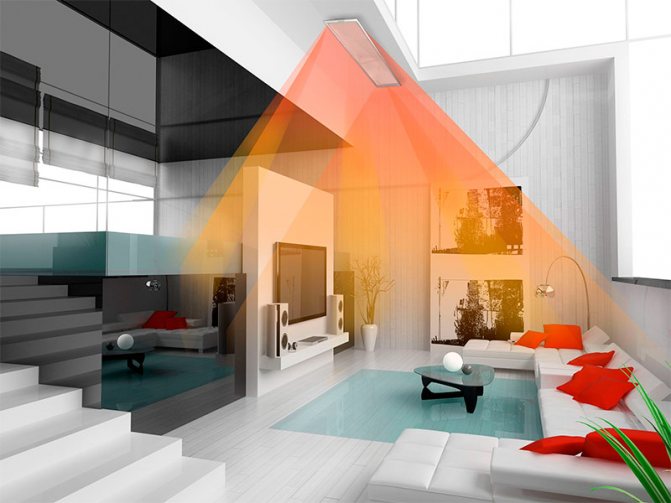
Uneven heating also manifests itself in the fact that radiant heat warms the area like light from a flashlight - wherever it hits. Therefore, on the one hand, the human body may even feel hot, and on the other, the coolness of the surrounding air can be felt. When operating the device in the open air, you will have to periodically rearrange it or turn it yourself to keep warm from all sides.
Negative effects on humans with prolonged intense exposure
In general, IR heaters are safe for health, but problems can arise if you stay under a high-temperature device that is constantly on for a long time. It’s the same as sitting under the sun for a long time - you won’t be able to tan from the infrared rays, but the concentrated heat will dry out the skin, and the body will not have time to compensate for the loss of moisture by removing sweat in this place. Overdried skin can then bake and peel. Therefore, it is not recommended to sit with one side of your body exposed to a constantly turned on heater.
Hazardous for children and pets
High-temperature IR heaters with spiral heating elements can cause burns if a person touches the bulb or reflector. Although the heating element of the IR heater is enclosed in a glass tube, the surface of the latter still gets very hot.
The heating element of the device is often covered with a metal grid with large cells, so children, out of curiosity, can easily stick their hand in there. In view of this, you should not leave the IR heater on and children in the same room unattended. A pet with long hair may be harmed if it rubs against the heater and the fur accidentally touches the heated coil bulb.
Bright light
Infrared heaters with tubular heating elements have another drawback - a bright glow. In daylight, this is hardly noticeable and only helps to see whether the device is working or not. In the setting of a street cafe, it is even attractive in the evening.

But in a room at night, such a “light bulb” can interfere with rest, continuing to shine brightly in the eyes. It is impossible to turn the housing in the other direction, because then the heat will be directed past.
Fire risk
This drawback again applies only to high-temperature models. The heater's tall stand allows it to be mounted at different levels to customize the direction of radiant heat depending on the user's location. The stand has a stand with four support points that provide a stable position, but a large dog in the house can easily knock over the device when running past. If this is not seen, touching the carpet or continuing to shine the light on the wood flooring in this position can cause a fire.
Having considered the topic of pros and cons of IR heaters from all sides, it will be easier for you to make your choice. And you can find out already tested and popular models that have positive reviews by looking at the next page of the site, which describes the best infrared heaters of all types.
Also useful for repairs:
- Active and inactive flux
- How to connect wired headphones to ps4
- How to make a small handbag

